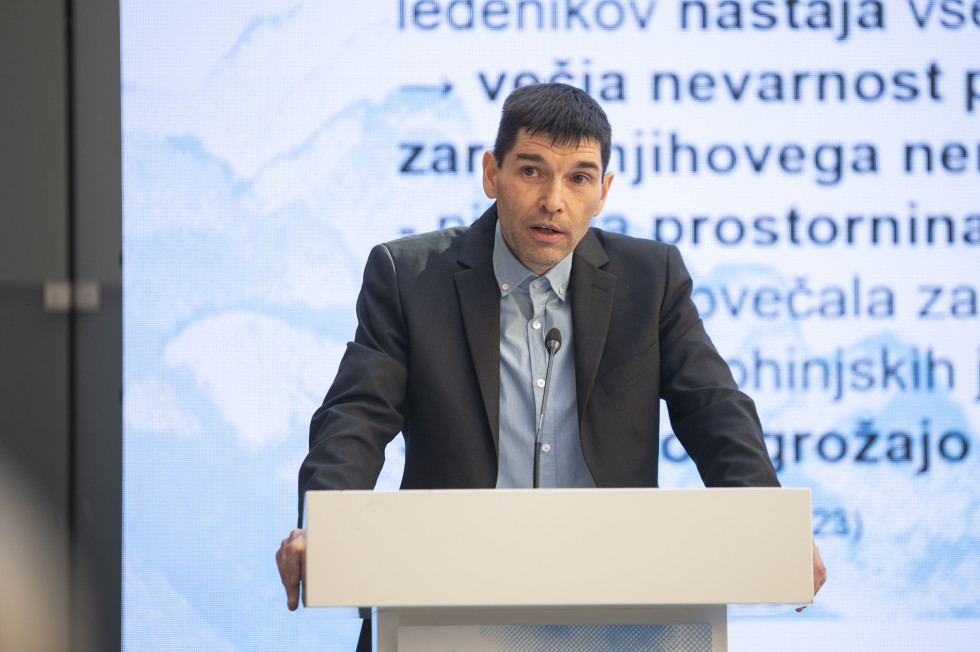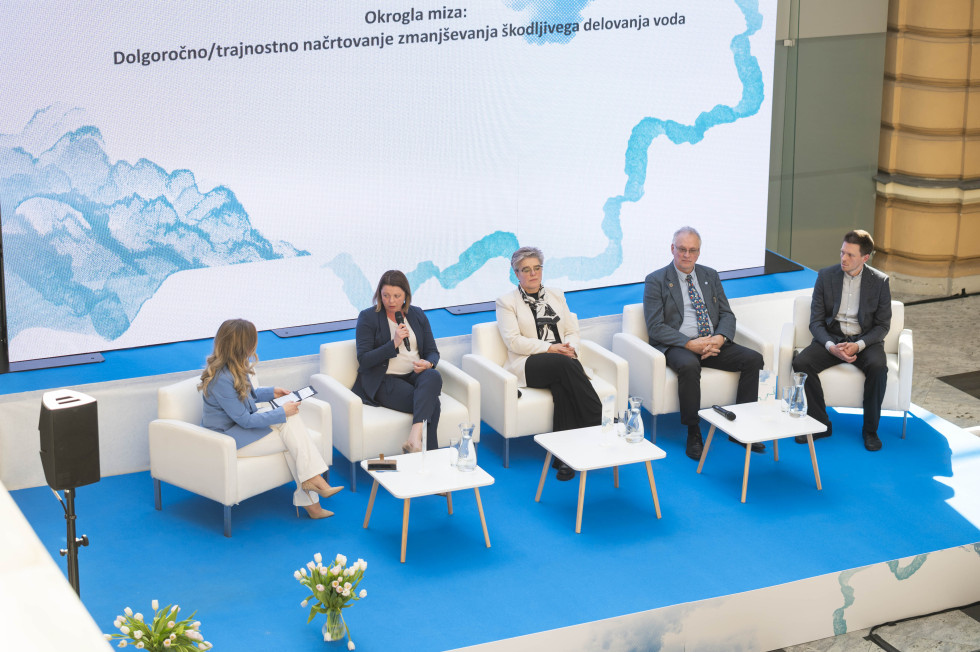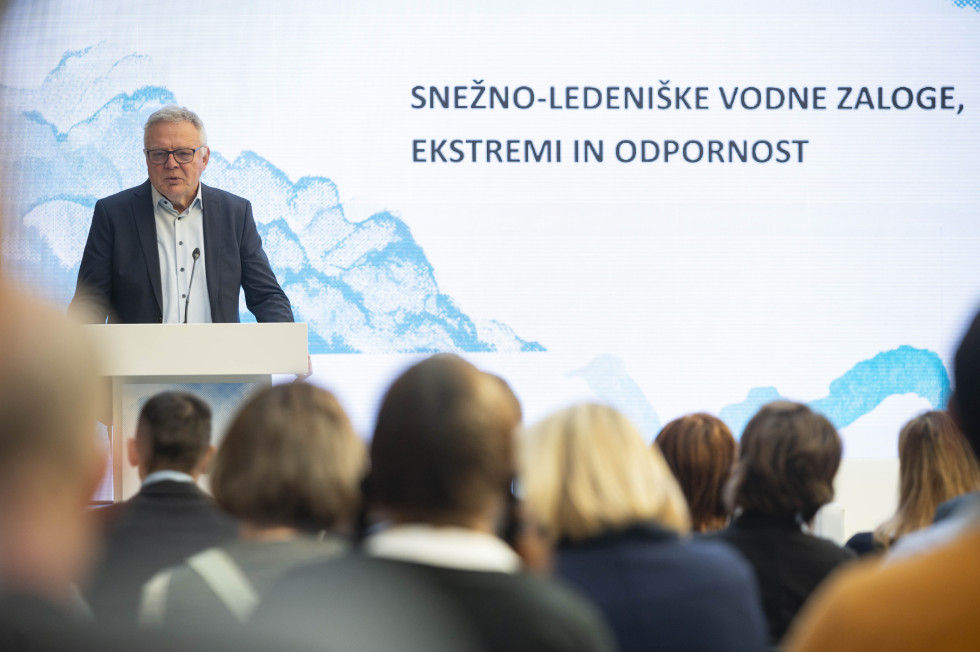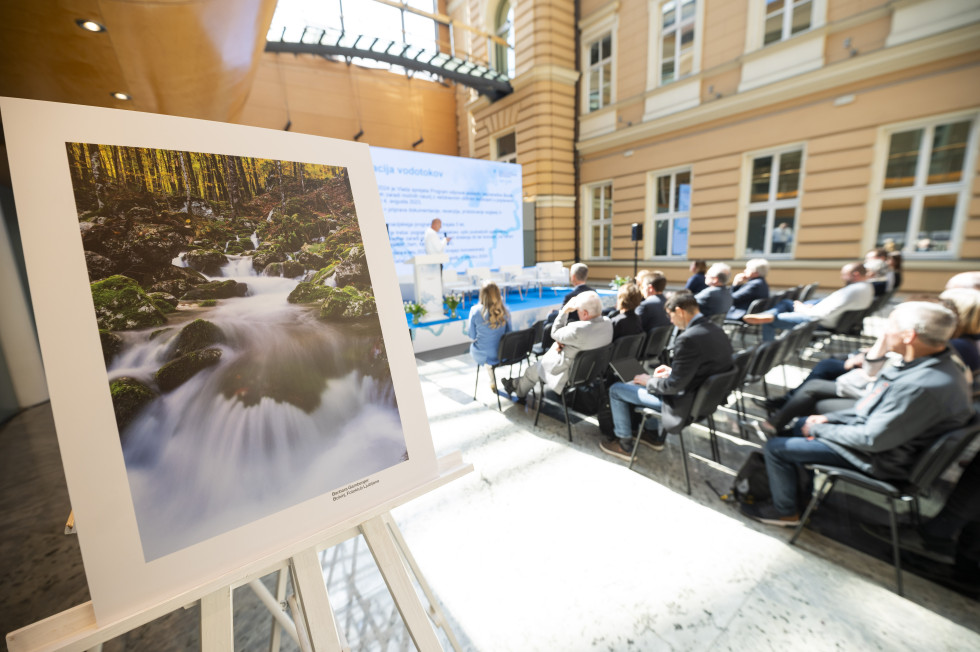Water Day marked by concern about the survival of glaciers and efforts to increase resilience to floods and avalanches
The United Nations has declared 2025 the International Year of Glacier Conservation to highlight the importance of glaciers in regulating global climate and hydrology and in providing drinking water. Slovenia has only a few small glaciers. Their existence is mainly linked to the water reserves in their headwaters, which, in winter, are long covered by a snow cover and are very important for maintaining river and groundwater flows, even in periods when there is no precipitation. However, the retention of water in headwaters brings with it the risk of landslides and flash floods.
"Today, I am pleased to see that in the aftermath of the floods, we have successfully focused on flood recovery, on rebuilding the affected areas - and also on strengthening the climate resilience of river basins more broadly. In this way, we have actively joined the global effort to increase the climate resilience of river basins. This is a resilience priority in the science and profession of modern societies." Jože Novak, Minister of Natural Resources and Spatial Planning.
The Ministry of Natural Resources and Spatial Planning understands climate resilient river basin management - including in transboundary cooperation - as strategic cross-sectoral integrated water planning and management. This takes into account social and development needs, challenges and opportunities related to water in a particular region, community or economic activity. In order to reconcile different water interests with the public good, sustainable water management must simultaneously take into account environmental, social and economic objectives. It is therefore important that adaptive and sustainable water management is also reflected in other policies.
Dr Lidija Globevnik, Director General of the Water Directorate within the Ministry of Natural Resources and Spatial Planning, presented the main highlights of the revised flood regulation. The concept of flood and erosion resilience is being introduced, through which the planned facilities and activities will be adapted to negative impacts of flooding and the resulting erosion: for normal facilities, 100-year water resilience, and for sensitive facilities, 500-year water resilience. Flood risk will now be defined for entire river basins. Flood hazard data will also be provided in the form of anticipated flood elevation angles.
Water resources, extremes and resilience
Since the mid-19th century, glaciers around the world have declined significantly. As pointed out by Dr Matija Zorn from the Institute of Geography at the Research Centre of the Slovenian Academy of Sciences and Arts, satellite records have shown that the thickness of glaciers has decreased by an average of about 14 metres since 1976. This has contributed to more than 22 millimetres of global sea level rise. By 2050, areas where 300 million people live today are projected to be below the level of the average annual coastal flood. The melting of glaciers in mountains is creating more and more glacial lakes, which pose a great risk of flooding in the event of a sudden spill.

dr. Matija Zorn | Author Boštjan Podlogar / STA
Managing torrents is a serious challenge for the profession. With 60% of Slovenia's forested areas, forest management in torrential areas needs to be adapted. Jože Papež from Hudournik company while presenting the situation and the possibilities of coexistence with torrents, made a special plea for an in-depth intersectoral dialogue and the search for synergies, in terms of investing in human resources, interdisciplinarity and sustainable approaches. There will always be a certain degree of threat and risk in a high storm water area.
One third of Slovenia is highly prone to landslides due to its geological structure and dynamics. he main trigger is rainfall. Dr Miloš Bavec from the Geological Survey of Slovenia explained in more detail the purpose of the landslide hazard maps. Their usefulness ranges from land use planning at municipal level and environmental impact assessment of planned interventions to the identification and avoidance of risks related to landslides.
Around 10,000 landslides, slides, debris flows and slumps were triggered during the August 2023 storm. Their rehabilitation is challenging. Bojana Janežič from Geoforma company presented the types of landslides and the main causes of their occurrence. She stressed the importance of drainage system construction in the case of rehabilitation. This is because it is a big responsibility when it comes to activities affecting the environment. The intensity of rainfall and the consequent occurrence of landslides and torrents with intensified erosion processes are hazards that must be strictly taken into account in planning and construction.
Dr Janko Logar from the Faculty of Civil Engineering and Geodesy outlined the planning of activities affecting the areas at risk. It all starts with spatial planning, continues with data and careful, knowledge-based planning of interventions. It is important to be present, to be aware of the situation on the ground. This does not overlook the maintenance of culverts and the inspection of the riverside space. The continuous development of databases, analysis tools and early warning systems is crucial.

Dan voda v avli osrednje ljubljanske pošte | Author Boštjan Podlogar / STA
Watercourse regulation
The World Water Day event continued with a presentation of measures taken following the catastrophic storms of August 2023. Interventions to ensure the safety of the population were followed by emergency measures ensuring the flow capacity of rivers. Longer-term measures are already underway, following the adoption of a five-year rehabilitation programme in May 2024, with the government earmarking EUR 1.36 billion for water infrastructure. The measures will provide sustainable and climate-resilient solutions.
Rok Penec from the Slovenian Water Agency gave a more detailed presentation of the scope of activities, which ranges from obtaining documentation, reviews and consents to permits and the implementation of flood risk reduction projects. Wherever possible, these will follow the concept of nature-based solutions. In addition to all the above, regular maintenance works are being carried out by the concessionaires in accordance with the annual plan received. This is performed to keep the water infrastructure in good condition. The series of measures is completed by investments in the construction of new water infrastructure facilities.
Long-term and sustainable planning to reduce the water-related harm
At the end of the Water Day, the panellists highlighted some of the key aspects that have an important bearing on long-term and sustainable planning to reduce water-related harm.

Participants in the round table (from left to right): moderator Maja Ratej, Dr Lidija Kegljevič Zagorc, Suzana Stražar, Dr Matjaž Mikoš and Gašper Zupančič | Author Boštjan Podlogar / STA
Dr Lidija Kegljevič Zagorc, State Secretary at the Ministry of Natural Resources and Spatial Planning, presented the scope of the Ministry's activities and the systemic changes it is facing. She pointed to the long-standing shortage of staff in the field of water and landslide management; however, there is a wealth of knowledge and data in Slovenia. The Ministry is working towards collecting and processing all data in a systematic way. Similarly, landslide monitoring and the preparation of hydrological-hydraulic studies are being established.
Dr Matjaž Mikoš from the Faculty of Civil Engineering and Geodesy presented his experience of working in the Water Council. He pointed out the right of the public to be informed about solutions, especially in Slovenia, where there are many active NGOs and local communities. He suggested that the Government should identify the neuralgic points and translate them into priorities so that it would be clear what needs to be changed in the system. He welcomed the Ministry's intention to pay more attention to landslides.
The Association of Watermen of Slovenia is actively involved in introducing the profession of a waterman to younger generations, especially secondary school students. Gašper Zupančič confirmed that the profession is well aware of the staff shortage and called for a systemic approach to the problem. He sees sustainable planning as a major technical challenge for the engineering profession. On the other hand, it is a social issue of where to locate, who to take space from and how much we as a society are able to finance the projects.
Suzana Stražar, Director of the Planning Office at the Water Directorate, pointed to the lack of uniform and digitised data and records needed for spatial planning. Things are already changing, developments have been made, and the water profession needs the most comprehensive studies and basin-specific solutions. Only in this way will it be possible to draw the right conclusions.



